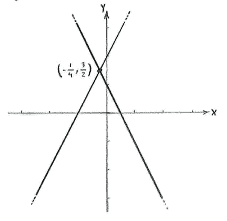Solution 2.2:6e
From Förberedande kurs i matematik 1
(Difference between revisions)
(Ny sida: {{NAVCONTENT_START}} <center> Bild:2_2_6e-1(2).gif </center> {{NAVCONTENT_STOP}} {{NAVCONTENT_START}} <center> Bild:2_2_6e-2(2).gif </center> {{NAVCONTENT_STOP}}) |
m |
||
| (4 intermediate revisions not shown.) | |||
| Line 1: | Line 1: | ||
| - | {{ | + | The lines have a point of intersection at that point which simultaneously satisfies the equations of both lines |
| - | < | + | |
| - | {{ | + | {{Displayed math||<math>2x+y-1=0\qquad\text{and}\qquad y-2x-2=0\,\textrm{.}</math>}} |
| - | { | + | |
| - | < | + | If we make ''y'' the subject of the second equation <math>y=2x+2</math> and substitute it into the first equation, we obtain an equation which only contains ''x'', |
| - | {{ | + | |
| + | {{Displayed math||<math>2x+(2x+2)-1=0\quad\Leftrightarrow\quad 4x+1=0\,,</math>}} | ||
| + | |||
| + | which gives that <math>x=-1/4\,</math>. Then, from the relation <math>y=2x+2</math>, we obtain <math>y = 2\cdot(-1/4)+2 = 3/2\,</math>. | ||
| + | |||
| + | The point of intersection is | ||
| + | <math>\bigl(-\tfrac{1}{4},\tfrac{3}{2}\bigr)</math>. | ||
| + | |||
| + | |||
| + | <center>[[Image:2_2_6_e.gif|center]]</center> | ||
| + | |||
| + | |||
| + | We check for safety's sake that <math>\bigl(-\tfrac{1}{4},\tfrac{3}{2}\bigr)</math> | ||
| + | really satisfies both equations: | ||
| + | |||
| + | :*2''x'' + ''y'' - 1 = 0: <math>\quad\textrm{LHS} = 2\cdot\bigl(-\tfrac{1}{4}\bigr) + \tfrac{3}{2} - 1 = -\tfrac{1}{2} + \tfrac{3}{2} - \tfrac{2}{2} = 0 = \textrm{RHS.}</math> | ||
| + | |||
| + | :*''y'' - 2''x'' - 2 = 0: <math>\quad\textrm{LHS} = \tfrac{3}{2}-2\cdot\bigl(-\tfrac{1}{4}\bigr)-2 = \tfrac{3}{2} + \tfrac{1}{2} - \tfrac{4}{2} = 0 = \textrm{RHS.}</math> | ||
Current revision
The lines have a point of intersection at that point which simultaneously satisfies the equations of both lines
| \displaystyle 2x+y-1=0\qquad\text{and}\qquad y-2x-2=0\,\textrm{.} |
If we make y the subject of the second equation \displaystyle y=2x+2 and substitute it into the first equation, we obtain an equation which only contains x,
| \displaystyle 2x+(2x+2)-1=0\quad\Leftrightarrow\quad 4x+1=0\,, |
which gives that \displaystyle x=-1/4\,. Then, from the relation \displaystyle y=2x+2, we obtain \displaystyle y = 2\cdot(-1/4)+2 = 3/2\,.
The point of intersection is \displaystyle \bigl(-\tfrac{1}{4},\tfrac{3}{2}\bigr).
We check for safety's sake that \displaystyle \bigl(-\tfrac{1}{4},\tfrac{3}{2}\bigr)
really satisfies both equations:
- 2x + y - 1 = 0: \displaystyle \quad\textrm{LHS} = 2\cdot\bigl(-\tfrac{1}{4}\bigr) + \tfrac{3}{2} - 1 = -\tfrac{1}{2} + \tfrac{3}{2} - \tfrac{2}{2} = 0 = \textrm{RHS.}
- y - 2x - 2 = 0: \displaystyle \quad\textrm{LHS} = \tfrac{3}{2}-2\cdot\bigl(-\tfrac{1}{4}\bigr)-2 = \tfrac{3}{2} + \tfrac{1}{2} - \tfrac{4}{2} = 0 = \textrm{RHS.}

